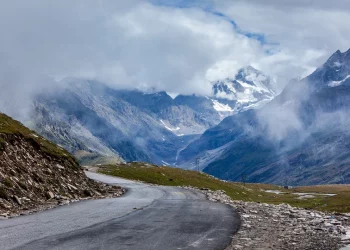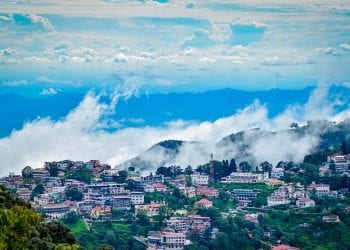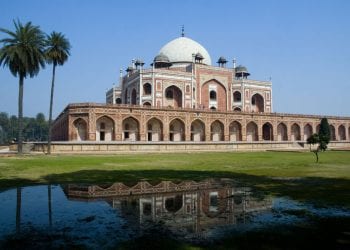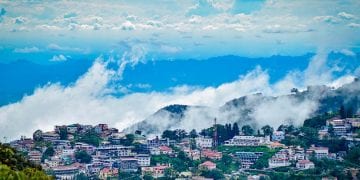Pilgrim’s Paradise in Puri – Temples You Need To Visit
The names Puri and Jagannath are synonymous. Their history is similar too – both have been plundered and looted – not for religious reasons but their wealth. Puri is a coastal district next to the river Mahanadi along the Bay of Bengal in Odisha. By 12-century AD, Puri was established as an important Hindu pilgrimage site. There are numerous temples in Puri, foremost being the Jagannath Temple. The tourism attracted by Jagannath contributes to nearly 80% of Puri’s economy. The treasury of Jagannath makes it one of the wealthiest temples in the world. The temple priests are descendants of the Gajapati Dynasty. Over 24 festivals are celebrated at Jagannath, most well-known being the RathYatra or Chariot Festival when the trinity idols are carried in three exquisitely decorated chariots through the streets of Puri.
Top 13 Temples To Visit In Puri
- Jagannath Temple
- PanchaTirtha
- Lokanath Temple
- Vimala Temple
- Varahi Temple
- Sakshigopal or Satyabdi Gopinatha Temple
- Darya Mahavir or Bedi Hanuman Temple
- Kapalamochana Temple
- Gundicha Temple
- Baliharachandi Temple
- Markandeshwar Temple
- Alarnath Mandir
- MausiMaa or Ardhashosini Temple
1. Jagannath Temple
Jagannath Temple is amongst the foremost holy places to visit for followers of Hindu Vaishnava traditions. According to Mahabharata, the construction of this temple was first commissioned by King Indradyumna. Later in the 12-century, the temple was developed under King Anantavarman of the Ganga Dynasty. As per trinity divination – Jagannath, Balarama, and Subhadra- are the presiding deities. The sanctum sanctorum contains their exquisitely carved wooden idols, which are periodically replaced by an exact replica. Surrounded by high fortified walls, this magnificent temple features Rekha Deula architectural style – divided into a sanctum sanctorum, an audience hall, an offerings hall, and a frontal porch. A Nila Chakra (Blue Discus) mounted atop the temple is regarded as a cult symbol for the Jagannath clan. The main entrance to the temple is through the Lion Gate, while the other entrances are the Elephant, Tiger, and Horse Gates. There are numerous other smaller temples and mandapa (porches) all around the complex. The temple’s kitchen, Rosaghara, is one of the world’s biggest. The temple is world-renowned for its annual chariot festival, or car festival, or Ratha Yatra Festival. The three presiding deities are brought out of the temple complex is massive and intricately decorated temple cars and toured through the Bada Danda Street to offer a darśana (view) to the devotees.
Timings: 5:30 AM to 10:00PM
2. Pancha Tirtha
For Hindu devotees, a pilgrimage to Puri is consummated only after taking a holy bath in five sacred places called Pancha Tirtha. Regarded as the starting point, the Markandeya sarovar (tank) is situated beside the famous Markandeshwar Temple. Next, is the well of Rohini Kunda (well), which is considered Narayan’s abode. It is located within the Jagannath Temple complex. A banyan tree next to it, Akshaya Kalpavat, is also worshipped. Next holy spot is called the Sea, or Mahodadhi, located within the Bay of Bengal in the Swargadwar area of Puri Beach. Its grand Samudra aarti is also a major attraction. Indradyumana Tanknear the renowned Gundicha Temple, and Swetaganga sarovar down south of Nilachal, are the other Pancha Tirthas.
3. Lokanath Temple
This 11-century temple is amongst the five famous temples of Puri dedicated to Lord Shiva. As per legend, it was established by Lord Rama. The complex is built as per Deula architectural style. The main temple is made of marble, while the remaining of sandstone. A Shiva lingam in the sanctum sanctorum is the presiding deity. A natural fountain flows above it, making the lingam remain immersed in water. Before the Shivratri Festival, all the water is ejected and the lingam becomes visible for darshan (sight) to innumerable devotees. In this way, the lingam is clearly visible only once a year. All the offerings -flowers, milk, yoghurt, sandal paste, honey, coconut water, leaves of beetle and bilva- made to the lingam throughout the year decompose in the water, producing a distinctive smell and taste. This mixture is taken as prasad and believed to have healing properties. An idol of Lokanatha inside the Jagannath Temple is symbolic of his role as the guardian deity of the treasures. Lokanatha participates in Jagannath festivals like Shivratri, Sital Sasthi, and Candan Yatra.
Timings: 5:00AM to 9:00PM
4. Vimala Temple
Vimala, or Bimala Temple is a small shrine located within the Jagannath Temple complex next to the sacred Rohini Kunda pond. Dedicated to goddess Vimala, this temple is considered a Shakti Peetha–amongst the holiest Shakti temples in India. Built of sandstone and laterite, it features a Deula style of temple architectural style. Vimala is regarded as the consort of Lord Jagannath, and she is also considered the guardian deity of Jagannath Temple complex. Devotees consider it essential to worship Vimala before praying in the main Jagannath Temple. Any offering to Jagannath is not sanctified as mahaprasad (ultimate offering) until it first offered to Vimala. The temple witnesses huge Durga Puja festival celebrations.
Timings: 5:00AM to 1:00PM, 4:00PM to 11:30 PM
5. Varahi Temple
The 9-century Varahi Deula Temple is famous for the masterpiece idol of its presiding deity, the Goddess Varahi. It is one of the temples in Puri known for its architecture. Her main idol presides in the center of sanctum, with two smaller Varahi statues on both sides. She is seated in lalitasana posture holding a fish in one hand and a kapala (skull) in another, and right foot on a buffalo – her consort. Her strikingly large belly symbolizes she holds the universe in her womb. The temple is situated within a quaint garden in the small village of Chaurasi. The style and shape of this Sakta Temple is different from other medieval temples. Unlike Rekha and Bhadra, it features a Khakhara style from Kalinga Dynasty, and has a semi-cylindrical shape.
Timings: 7:00AM to 10:00AM, 5:30 PM to 8:30 PM
6. Sakshi gopal or Satyabdi Gopinatha Temple
This medieval temple built in the Kalinga style of temple architecture is dedicated to Lord Gopinatha, a form of Krishna. A couple’s tale of love and hardship culminated into the manifestation of this temple as a stone statue of Lord Gopala, and the couple was appointed its first priests. Earlier called Satyabadi Gopinatha, the temple came to be known as Sakshi gopala, possibly after the Sakshi Gopala idol preserved in the town. It refers to one of the 16 idols of Gods carved from an exotic, imperishable stone by orders of King Vajra, Lord Krishna’s grandson. It is a unique Vishnu temple for its prasada – as the food offerings are made of wheat and not rice. The temple is famous for its annual celebration of Amla Navami Festival, which is associated with the ritual of touching Goddess Radha’s feet.
Timings: 6:00AM to 9:00PM
7. Darya Mahavir or Bedi Hanuman Temple
Dedicated to Lord Hanuman, Darya Mahavir is a small temple next to the sea. A two-armed Hanuman, with a laddoo (sweet) in the left hand, a gada (mace) in the right hand, is the presiding deity of the temple. The exterior walls of the temple are carved with several deities like Anjana and Lord Ganesha. The temple is also called ‘Bedi Hanuman’, meaning ‘Chained Hanuman’, from the legend that by orders of Lord Jagannath, Hanuman was tied next to the beach as a lesson to be more vigilant when he failed at his duty of preventing sea waters from entering Puri. Panasankranti, Rama Navami, and Hanuman Jayanti are some popular rituals observed in the temple.
Timings: 6:00AM to 6:00PM
8. Kapalamochana Temple
Kapalamochana Temple is amongst the Pancha Pandava or five famous Shiva temples of Puri. According to Hindu belief, worshipping Lord Kapalamochana helps one atone for ‘brahmahatya’ (killing of a Brahmin). The temple interiors have a ten-armed idol of Goddess Shyamakali. The walls are carved with images of gods like Shiva, Vishnu, and Narasimha. A sandstone idol of Ganesha is without his mount mouse – suggesting its antiquity. Manikarnika is a sacred pool located within the temple premises. Kapalamochana is associated with the Chandana Yatra Lord Jagannath Festival.
9. Gundicha Temple
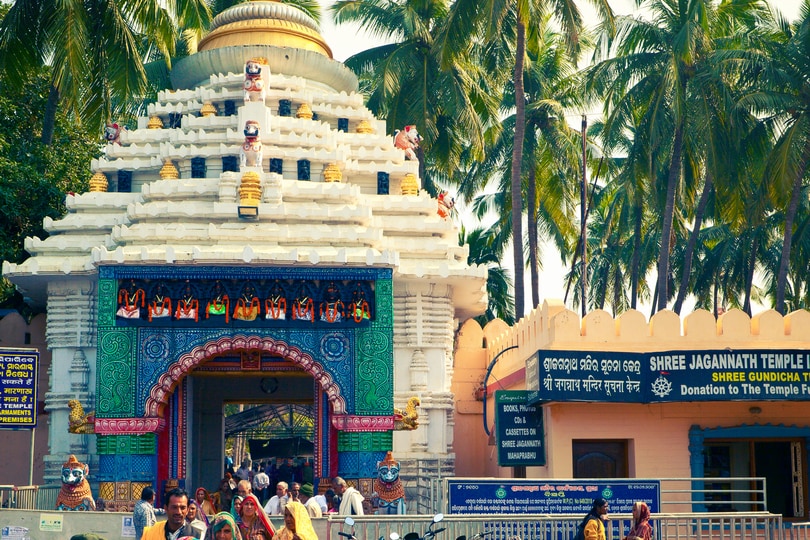
Gundicha temple is significant as the destination of the legendary Rath Yatra festival from Jagannath Temple. For nine days, the temple remains occupied by the trinity idols of Jagannath, Balabhadra, and Subhadra. A darshan (sacred view) of the idols, while they are in Gundicha, is considered most auspicious – even more than their darshanat Jagannath. But for the rest of the year, the temple remains vacant. The structure sits amidst a garden surrounded by walls. It is made of light-grey sandstone and built in Deula style of Kalinga temple architecture.
Timings: 6:00AM to 3:00PM, 4:00PM to 10:00PM
10. Baliharachandi Temple
This sea-side temple is popular not only as one of the holy places to visit but also a fun place! Situated near the meeting point of the sea and river Bhargavi, the sandy beaches next to the temple make it a perfect scenic spot, especially during sunrise and sunset. As a goddess of water and navigation, the presiding deity of this temple is especially revered amongst the fisherman and boatsman. A form of Goddess Durga, she is worshipped as the eight-armed Baliharachandi. The rituals of the Mahanavami Festival associated with Jagannath Temple are celebrated at Baliharachandi.
Timings: 5:00AM to 12:00PM, 4:00PM to 9:00PM
11. Markandeshwar Temple
This site is known as the spot where sage Markandeya meditated. The Markandeshwar Temple is amongst the five famous Shiva temples in Puri, and amongst the 52 sacred places for Shiva worship. A Shiva lingam is its presiding deity. The Markandeya sarovar next to the temple is a water tank regarded as one of the Panch Tirthas of Puri. The complex has a flight of steps, or ghat, leading to the tank to provide space for bathing. The steps are carved with ancient inscriptions, possibly dating back to the Ganga Dynasty. Many rituals of the Jagannath Temple festivals are celebrated at Markandeshwar with great fervor.
Timings: 5:00AM to 12:00PM, 4:00PM to 9:00PM
12. Alarnath Mandir
It is believed that Lord Jagannath leaves Puri during the Ashadha month of the Hindu calendar. This period is called ‘anavasara’, meaning ‘a lack of opportunity’. At this time, Jagannath manifests at Alarnath Temple in Brahmagiri, as Alarnath Dev. Lord Alarnath is the presiding deity of this temple dedicated to Lord Vishnu. The four-armed deity idol holds a chakra (wheel) and conch in upper hands, and a lotus and club in lower hands. Chandan Yatra is an annual sandalwood festival celebrated for 21 days at the lake behind the temple.
Timings: 6:00AM to 9:30 PM
13. Mausi Maa or Ardhashosini Temple
Two legends give this temple its two names. One legend states that this place was native of Lord Jagannath’s ‘mausimaa’ – a ‘mother’s sister’ or aunt. Another legend mentions Mausi Maa as the savior of Jagannath’s abode when Puri was flooded. Henceforth named Ardhashosini, this small temple is dedicated to her. During the return journey of the Ratha Yatra of Jagannath Festival, the chariot stops at Mausi Maa Temple and receives her offerings – Jagannath’s favourite- Poda Pitha, a type of baked cake.
Timings: 6:00AM to 9:00PM
In ancient times, depending on the ruling dynasty, Puri was called Purusottama Dham, Purusottama Kshetra, or Purusottama Puri. It was always a pilgrims land – frequented by sages like Bhrigu, Atri, Markandeya, Chaitanya Mahaprabhu, Adi Shankaracharya, Sri Yukteswar, and Ramanuja. There are several religious sites in Puri, especially many mathas (monastery of Hindu sects). The city is globally renowned as a significant Hindu pilgrimage site. Puri is popular for its crafts of sand art and applique art. It is also amongst the Indian cities chosen by the government for heritage development. Enchanting temples, colorful festivals, and lovely beaches make Puri a perfect getaway destination.
P.s. You might like these related resources:
- The best time to visit Puri and explore its various attractions
- Weekend Getaways from Puri- The Spiritual city of Odisha
- 12 Magnificent Places In and Around Puri That Will Awaken Your Spirituality
Recent Posts
Top Picks
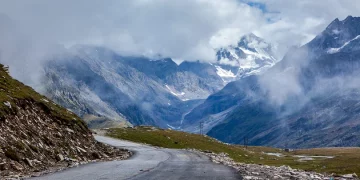
- OYO
 15 April, 2024
15 April, 2024 - Cultural Tour

- OYO
 15 April, 2024
15 April, 2024 - Cultural Tour

- OYO
 15 April, 2024
15 April, 2024 - Cultural Tour

- OYO
 15 April, 2024
15 April, 2024 - Cultural Tour

- OYO
 15 April, 2024
15 April, 2024 - Cultural Tour

Please rotate your device
Please go back to portrait mode for the best experience




 April 15, 2024
April 15, 2024 